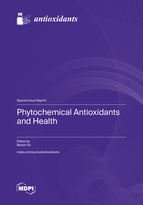Phytochemical Antioxidants and Health
A special issue of Antioxidants (ISSN 2076-3921). This special issue belongs to the section "Health Outcomes of Antioxidants and Oxidative Stress".
Deadline for manuscript submissions: closed (30 September 2019) | Viewed by 150302
Special Issue Editor
Interests: phytochemicals; natural products; functional foods; human health
Special Issues, Collections and Topics in MDPI journals
Special Issue Information
Dear Colleagues,
It is widely accepted that free-radical-induced oxidative damage is involved with various human diseases, such as cardiovascular diseases, neural disorders, such as Alzheimer’s and Parkinson’s disease, diabetes, obesity, and various cancers. Antioxidants are substances that delay or inhibit oxidative damage when present in small quantities compared to an oxidizable substrate. Therefore, antioxidants can help in disease prevention by effectively quenching free radicals or inhibiting damage caused by them. It is recognized that the health effects of natural products including food and herbal medicines are generally associated with antioxidative activities or free radical scavenging properties of phytochemicals.
We invite you to contribute your latest research findings or a review article to this Special Issue, which will bring together current research concerning and critical thinking on phytochemical antioxidants, and the role that antioxidants can play in reducing oxidative stress in various disease statuses. Your contribution can include either in vitro or in vivo studies relating to any of the following topics: Antioxidative activities of phytochemicals; molecular mechanisms of phytochemical antioxidants in disease prevention; and the role of phytochemicals or antioxidants in signaling, cell metabolism, cell cycle, cellular stress, and chronic diseases.
We look forward to your contribution.
Prof. Baojun Xu
Guest Editor
Manuscript Submission Information
Manuscripts should be submitted online at www.mdpi.com by registering and logging in to this website. Once you are registered, click here to go to the submission form. Manuscripts can be submitted until the deadline. All submissions that pass pre-check are peer-reviewed. Accepted papers will be published continuously in the journal (as soon as accepted) and will be listed together on the special issue website. Research articles, review articles as well as short communications are invited. For planned papers, a title and short abstract (about 100 words) can be sent to the Editorial Office for announcement on this website.
Submitted manuscripts should not have been published previously, nor be under consideration for publication elsewhere (except conference proceedings papers). All manuscripts are thoroughly refereed through a single-blind peer-review process. A guide for authors and other relevant information for submission of manuscripts is available on the Instructions for Authors page. Antioxidants is an international peer-reviewed open access monthly journal published by MDPI.
Please visit the Instructions for Authors page before submitting a manuscript. The Article Processing Charge (APC) for publication in this open access journal is 2900 CHF (Swiss Francs). Submitted papers should be well formatted and use good English. Authors may use MDPI's English editing service prior to publication or during author revisions.
Keywords
- Antioxidants
- Oxidative stress
- Free radical scavenging
- Phytochemicals
- Molecular mechanisms
- Health promotion
- Disease prevention







